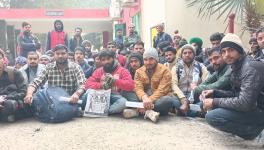UP Elections: Vantangiya Voters Still Miles Away from Mainstream, Struggling to Get Land Titles
Gorakhpur/ Maharajganj (Uttar Pradesh): As the boundary wall of the Mahayogi Gorakhnath Airport ends, take a right turn at Gorakhpur-Kushinagar road. You will be lost in the scenic beauty of nature — lush green farms protected by the Forest Department and mesmerising geographical symmetry of Sakhu (sal) trees grown right into the sky.
Walk straight on an earthen path and go deep inside the forests. The landscape suddenly changes. You will find small villages dotted in the forests that will make you realise the stark contradictions of life.
Amid reflections of modern life in the form of dish antennas fixed atop houses, electricity, brick or interlocking roads and two-wheelers zipping around, you will find abject poverty, children without proper clothing and visible despair on people’s faces.
These settlements belong to the Vantangiya people, who were brought here from Myanmar by Lord Mountbatten during colonial rule for afforestation activities. ‘Van’ means forest, and ‘Tangia’ is a distortion of the word for the Burmese technique of shifting hill plantations.
Vantangiya is not a community but a group of forest dwellers belonging to various Other Backward Classes (OBC) such as Nishad, Maurya, Gaur, Yadav and Dalits. A majority are Nishads and Gaurs.
“Land title is our major poll issue. We were allotted pattas (land deeds) in 2011 by the then Mayawati government. But we are still deprived of the khatuni (record of rights). The land in our possession is still not our property as the Forest Department has its title. We are living at its mercy, and it can evict us whenever it wants,” Vishambhar Maurya, a resident of Rajgadh, Rajahi, Aambagh in Chargawan block, told NewsClick.
He said one could not get bank loans against the patta, nor can anybody access health services in the absence of khatauni.
The village has 150 houses with around 750 families. Most of the houses were newly constructed. The villagers said the pakka houses had been funded by the housing scheme of the Chief Minister (CM) and Prime Minister (PM).
“Unemployment is the second major problem of the residents. Most of us are daily wagers who work as construction labourers in the district or big cities such as Delhi. Those who work locally don’t get work even 15 days a month. In addition, the wages, which range between Rs 350-400/day, are too low to make ends meet for a family of four (husband, wife and their two children) in this age of high inflation,” he complained.
Maurya is called mukhiya of the Vantangiyas, but not an elected gram pradhan (village head). He said his village was adopted by actor-turned-politician and Gorakhpur MP Ravi Kishan. The villagers equivocally alleged he never turned up there after 2019 when he had visited the village to inaugurate a primary school.
“After 2019, he came here in 2021 to shoot a movie but did not bear the pain to visit the village. He stayed in the Forest Department’s guest house and returned. The adoption was just for namesake,” they added.
The villagers here are loyal voters of the Bharatiya Janata Party (BJP) because they said whatever small development such as the construction of pakka houses, electricity supply, construction of brick roads, etc., took place, happened in the past five years when Yogi Adityanath became the CM.
“Earlier, we were not even considered citizens of this country as we did not have voter identity cards. We got our ration cards recently. The roads and the primary school came under the BJP rule. This could have been done by the previous governments as well,” said Kamlesh Nishad, 24.
He is a first time voter and is very excited to use his right to franchise on March 3, the sixth phase of the ongoing UP elections.
When told what they received in the past five years, they had it after producing the legal ownership document (patta papers) of the land they possess, he agreed and said earlier they used to live life like nomads. They used to stay on a patch of land for five years for planting trees and looking after it, and when the plants grew, they used to be shifted by the Forest Department on another patch for afforestation. This is how the forest came into existence.
“Still, we have to travel eight kilometres on foot to cast our votes,” he added.
The villagers further complained that not all in the Vantangiya villages have legal ownership of the land in their possession, and whoever got it did not get patta of the entire plot of land.
Maurya does not have even an inch of legal land despite furnishing all papers with the department concerned.
Shyam Yadav, 40, is the legal owner of 15 kattha (0.46 acre) of the 25 kattha (0.77 acre) of land in his possession. Kamlesh on paper owns 26 decimal (0.25 acre) of the 30 decimal (0.29 acre) of the total. Kalavati Devi has a patta of 10 kattha (0.30 acre) of the 16 kattha (0.49 acre) among her four children. Vijay Nishad is landless and illegally occupies 10 kattha (0.30 acre) of land for farming activities. Ramdev, 65, has possession over 15 kattha (0.46 acre) of the land but has a legal ownership document of only eight kattha (0.24 acre).
The same story continues in almost all five villages of the Vantangiyas. There are five villages in Gorakhpur district and 18 Vantangia villages in the neighbouring Maharajganj district. Apart from this, five in Gonda, five in Balrampur and one village in Bahraich.
Rajahi Aambagh has a newly constructed interlocking road measuring 720 metres. It was constructed under Mahatma Gandhi National Rural Employment Guarantee Act (MGNREGA) two years ago, but the residents are still awaiting their wages. Maurya said 53 people in his village have MGNREGA job cards, but they got work once in the past two years.
A few kilometres away from the village in the opposite direction lies the other forest village Tinkonia Jungle-3, which CM Adityanath had adopted. It is a comparatively dense village with an amalgamation of kutcha and pakka houses.
Talking to NewsClick, Sonu Nishad, who earns livelihood from a ration shop, vented his anger.
“The prices are skyrocketing. There is no job. People get MGNREGA works once in a blue moon. The petrol and diesel prices have been reduced by Rs 10/litre just ahead of the elections. Chunav khatam hote hi tel ka rate badhega aur soodh ke saath badhega (once the elections are over, the fuel prices will not only increase, it will be hiked with the interest of what has been reduced),” he presumed.
Though the villagers here also complained about the land title, they were hopeful that it would be done if the government was re-elected.
“We lived in thatched-roof katcha houses. There was no light, school or healthcare facility. The nights always scared us because our animals and infants became targets of wild animals. Life has changed now,” said Sandhya Devi, a primary school teacher, who is hoping that the pending works will be completed in the years to come.
The CM declared 18 Vantangiya settlements in the region in January 2018 as revenue villages to bring the residents here to the mainstream.
A revenue village is a small administrative region with defined borders. One revenue village may contain many hamlets. A village officer is the head officer of a revenue village. But this decision is not proving to be of great help.
The people still face problems related to the use of natural forest produce like fruits, honey, wax, wood and leaves to meet their daily needs as the forests inhabited by them are not considered as revenue villages under the provisions of the Scheduled Tribes and Other Traditional Forest Dwellers (Recognition of Forest Rights) Act. The aim was to enable the administration to adopt development measures such as setting up schools, dispensaries and other facilities in these villages. But most of the facilities are still a distant dream for the residents here.
It must be noted the children of Vantangis, who made the Gorakhpur-Maharajganj district of eastern UP green by planting thousands of acres of hectares of precious sakhu-teak forest in 100 years, are now engaged in daily wage work such as applying tiles, paint-polish in cities like Mumbai, Pune, Hyderabad, Delhi to make their ends meet.
During the first and second waves of the COVID-19 pandemic, thousands of labourers have returned to more than 20 Maharajganj and Gorakhpur district forest villages.
Vinod Tiwari of Sarvahitkari Seva Sansthan, an organisation that has been relentlessly working among the Vantangia community for three decades, said it took 15 years to get the people of Vantangia village their due and to connect them to the mainstream of the society.
After several rounds of talks with the delegation of Vantangia labourers, the state government announced to enact Scheduled Castes, Tribes, and Traditional Residents Act 2006 to give them the rights. Its manual was framed in 2007, and it was implemented in December 2008. It was provided in this law that families who show proof of having lived in the forest for three generations will be given their due rights on the forest land. Even after the enactment of the law, due to some technical flaws left in it, Vantangia workers were not getting the rights.
Forest Farming An Uphill Task For Community
The Forest Department gives empty land to the people for the Tangiya method. They have to clean the ground and plough it with the help of bullocks to make it sustainable for farming. The plants are sown in a line, and there is a distance of 15 feet between two trees. They have to grow their crop in this distance. The forest department used to take half of the total yield, and they had to survive on the other half. In the second year, when the trees started to grow, the cultivation between the trees had to be cleared with a shovel, and in the fifth year, they had to clear their cultivated fields and repeat this process on another empty land. For this, many people resided in their fields themselves, and at some places, a community living place for Tangiya labourers was created.
Get the latest reports & analysis with people's perspective on Protests, movements & deep analytical videos, discussions of the current affairs in your Telegram app. Subscribe to NewsClick's Telegram channel & get Real-Time updates on stories, as they get published on our website.
























